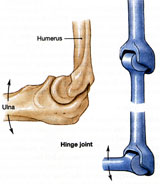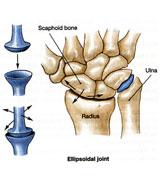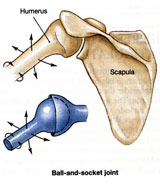Joint Types:
Even though there are more than 180 joints in the body, when it comes to moving you around, they can be broken down into 3 types:
- ball and socket joints
- hinge joints
- multiple joints.
The larger ball and socket joints located at your pelvis and the smaller ball and socket joints of the shoulder comprise your core structure.
The 4 limbs then follow the pattern of a strong but less flexible hinge joint followed by a more flexible multiple joint.
Joint Ranges of Motion
Each joint has a general range of motion within which it can efficiently function:
Average ranges of motion for the lower extremities
Average ranges of motion for the spine
Average ranges of motion for the upper extremities
All movement requires a coordination of joints which emanates from your core structure outward to the extremities. As long as this integrated joint system remains alignment, overall motion is fluid, accurate, and wonderfully invigorating. Should postural deviations develop, however, the whole structure starts wrenching out of alignment.
Mechanical Alignment
All machines require that the composite parts are in alignment with one another in order to function properly. The doors in your home, the zipper on your purse, the tires on your car etc., all require that the parts are in alignment with one another in order to function properly.
From a mechanical standpoint, your joints function properly when they remain within their given range of motion as defined by their joint type. The muscles surrounding the joints are responsible to provide the necessary tension to maintain alignment both with the joint and between the joints.
Loss of mechanical alignment leads to extreme wear and hastened break down.
Joint Pump
The rate of healing of most body tissue is directly related to degree of blood vessel innervation. The circulatory system is the transport infrastructure that services the joints and the blood cells are the transport vehicles that bring supplies and remove waste. The greater the blood supply, therefore, the faster the healing process can take place.
Of the 5 main types of joint tissue: muscle, bone, tendon, ligament, and cartilage, muscle and bone tissue are the most densely impregnated with blood vessels and heal most quickly. On the other end of the spectrum, cartilage receives no blood supply and heals the most slowly.
Continuing research reveals that cartilage does have an ability to heal itself but it relies on a completely different mechanism to do so.
Cartilage is a tough jelly-like substance that covers the articulating surfaces of joints. Within this jelly are pockets where cells live. These cells can divide and multiply adding layers of cartilage from within.
The articulating joints are surrounded by a liquid filled capsule that bathes the joint with a lubricating fluid called synovial fluid. The inside of the capsule contains a layer of cells called that release nutrients into this synovial fluid and remove waste products from the fluid. The cartilage cells therefore clean and repair themselves via the synovial fluid rather than via a direct blood supply.
An important distinction to be made between blood and synovial fluid, however, is that blood has a pump, the heart, that keeps it moving 72 beats per minute, 5,700 liters per day. Synovial fluid has no pump to keep it circulating, so it must depend on movement to keep it fresh. This mechanism is often referred to as the “joint-pump”. Much like stirring the honey in your tea, joint movement circulates the synovial fluid enabling it to seep through the cartilage, nourishing the cells and removing cell waste. It is a wonderfully functioning mechanism, as long as a person keeps moving!
Joint Health Maintenance
All movement brings with it a slight amount of wear and tear that causes the involved cells to break down and need replacing.
Of the 100 trillion cells comprising your body, roughly 3 billion of them are replaced every minute. Your body is quite up to the task, however, as it comes equipped with a marvelous cellular repair and replacement mechanism that works non-stop without disrupting normal organ function. This everyday maintenance mode is called stasis where the maintenance crew is “keeping up with the up keep” of the body.
Should trauma/injury occur, your body’s repair mechanism kicks into overdrive to restore the injured site as quickly as possible. Although the rest of the body continues receiving maintenance, grand-scale renovation is now taking place at the site of the injury. Similar to a building under renovation, the injured area becomes busy with activity. White blood cells actively demolish injured cells and red blood cells actively deliver new building materials needed for cell replication. It is all this microbiological repair activity in the injured area that leads to the crowding that leads to swelling. The swelling itself often brings with it various degrees of discomfort, but it is a part of the body’s natural self-repair mechanism that should be permitted to function as much as is bearable. In a well-nourished, structurally aligned body, the swelling will start to decrease as the repair process progresses.
If proper postural alignment is lacking, however, then the normal, everyday joint wear becomes replaced by constant low-level joint trauma. If the breakdown process is greater than the repair process can handle then the swelling and resultant discomfort will become chronic and in time spread to other joints. A vicious chain reaction of misalignment-compensation occurs among the joints and chronic breakdown occurs within the joints. Such a person faces a growing nightmare of pain and inactivity.


